– JOINT ARTICLE WITH PROF ŞENER ÜŞÜMEZSOY – THE REDSKIN! –

Ethnic and religious identities are all pleb categories. They are not determinative. But they are tools in the hands of rulers. We can not understand the logic behind violence by looking at them. That nowadays typical offscouring social scientist model seeking the truth in cultural and identity researches provides the kind of information that can make these pleb categories to both embrace or combat each other. However the rulers do not take decisions according to that kind of information but they think on what to do according to systemic and geopolitical necessities that here we seek their pathways. And it is only afterwards that the rulers use that information provided by offscouring – identity politics – “academician” to fabricate whatever needed – the clash or the hug, the enmity or the fraternity – within plebs. It was for this reason that we have already explained that the nowadays type of postmodern / post-structuralist academics and academy was not able to produce “science” and “knowledge” (conoscenze; conaissance; savoir) in the real sense of the word but could just produce “information”. It produces data and stores, categorizes and presents it -in-form-of- “information”, but it can not convert it into “knowledge”, since it does not have a complete understanding of human life to come up with a political project, that is to say, a “big narrative”. In other words, they lack the jakoben spirit that they should bear by the very definition of the word “academy”. For this reason, they can not escape but being tools to rulers.
We showed this map hereunder at the end of our last article (click and read) handling the new Transatlantic-Russian alliance and the reflections of this alliance in the abyss of the Middle East, as the outcome of American Shale Gas revolution:
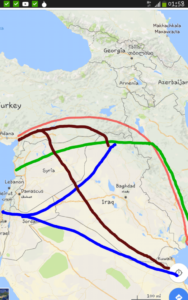
And these were the findings of our article in summary (in which we missed looking at the Persian Gulf through a magnifying glass):
1) Global capitalism has completed its final 70 years Kondratiev cycle in 2007 market turmoil. It will then only be possible to overcome the ongoing deflationary great depression by implementing the guided (Keynesian) fiscal-financial policies that may loose off a leap to a new model of capital accumulation.
2) Technological accumulation is at such a level that may this leap be possible in developed geographies, fundamentally transforming the lifestyle, consumption culture, aesthetic and quality of life perceptions of masses – these technologies are briefly defined as GNR, namely Genetic, Nanotech and Robotics.
3) The main target of this leap is to commercialize the electricity-based technologies that shall be generated from large scale natural gas thermal power plants mainly by state-led infrastructure investments.
4) Therefore, the goal of Transatlantic-Russian alliance is to establish permanent and safe means of natural gas transmission routes from the reserves into advanced civilization geographies having high potential to adopt, commercialise and consume such new generation artefacts.
5) The rise of Shale Gas – which is actually into US monopoly – made the US ruling elite to realize that they own the world’s largest oil and gas reserves. So their target is to restructure and expand US dollar’s seigniorage by founding a new energy dependency network for other major economies. This is the Trump government’s mission.
6) Russia has the world’s largest conventional gas reserves (“conventional” is in the sense that their resources are operated through shallow drillings as opposed to Shale Gas operations).
7) With the obvious evidence that one can neither obstruct nor narrow the other’s energy market by their military capacity and their geographical positions, we should deduce that the two superpowers were not in contradiction but in alliance in the Middle East.
8) The world’s third largest – and also conventional, ie, easily operational – gas reserves are located on the shores of the Persian Gulf.
9) So to conclude out of the world map and the US Geological Survey Institute (USGS) reserve reports, we should be able to see the logical necessity of US-Russian alliance in the Middle East.
Now let’s look into the abyss of the Middle East through a magnifier glass. Who shares gas reserves in the Gulf:
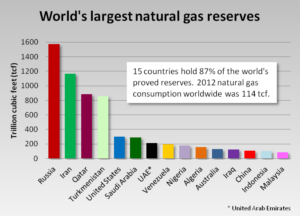
Please reckon the US position in this chart above, since it just shows “conventional” gas reserves – as previously noted, the US owns the largest reserves in the world thanks to its Shale Gas technology. So, as we can see in this chart, just Iran and Qatar have remarquable gas reserves. The Saudi Arabia has oil but not gas.
Gas can be transported from one location to another only by one of these two ways:
1) Pipeline laying: Gas is transported in the form of gas, which is called “dry gas” – it is expected that the natural reserve meets the pipeline cost – which increases by distance – and a minimum 50 years of operational period.
2) LNG: Liquefied natural gas, which is condensed by gas cooling and made liquid and transported by tanker ships – this requires coastal liquefaction plants and ports. The customer too must have ports with pressurized facilities to first store the liquid gas and then to convert it into gas and distribute.
Now let’s look at the following chart to see how Qatar sells its gas:
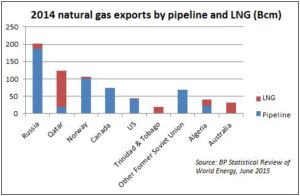
As we have seen, Qatar is able to sell its gas almost only by liquefaction and via sea port (in LNG form). Because it has no pipeline. Considering that even BAE and Kuwait began purchasing LNG from the US via tanker ships – the US Shale Gas exports from Cheniere to these Gulf countries began in 2016, as we reported in our previous articles, argueing that this event would be the beginning of the end of Arabic Gulf Countries.
As for Iran, there is a pipeline project that has been laid to Pakistan and to be gradually extended till India and then to China, which has been planned since the 1980s but can not be finished anyhow. It – was – expected that the Pakistan section of this project shall have been completed by the end of 2017 (the pre-crisis information). The crisis may evolve in a way to nullify this expectation. So the “danger” is the connection of Qatar to Iran to mutually feed this line towards India and China. We also know that the US had previously asked to the Pakistani government to annulate this project in exchange for providing loans to build a port of LNG terminal:
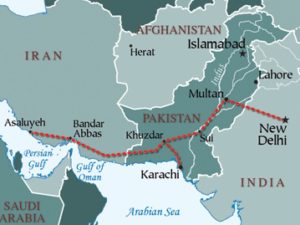
So here is how we can understand the logic of Qatar – Iran flirt. In such a situation where all the roads to the West are obstructed, Qatar needs Iran to sell its commodity, while, moreover, having considered that right next to it there is a pipeline that is being built crossing Iran towards the east …
Tayyip is another factor for Qatar – Iran flirt. Let’s look at the red line on the first map (the last map of our previous article): this line is Nabucco. This shows us that Qatar can also transfer its gas to Turkey (and to Mediterranean Europe via Turkey) through Iran. While the supplier of this project may only be Iran, Qatar could also be engaged into it (while Turkey is still trying to keep Nabucco alive, the crisis may evolve in a way to entirely annulate this project).
So do we see how the Sunni – Shiite brotherhood is constructed here? But just one specific kind of “Sunni” (the so called “Muslim Brotherhood” species) can brotherize (the gas brotherhood) the Shiites, while the Saudi type (the so called Salafi species and so on) still remains enemy.
What we try to explain is always the same rule: whatever the trash we call as Sunni, Shiite, Allavi, Nusayri, Muslim, Turkish, Kurdish, Jewish, Armenian, Arabic, Salafi, Hanafi, all such ethnic, religious, sectarian identities are nothing but just plebeian categories. They are not determinative. But they are tools in the hands of rulers. We can not understand the logic behind the violence by looking at them. The nowadays type of social scientist seeking the truth in identity-culture studies does nothing more than providing the kind of instrumental information implementing either to embrace or to fight these pleb categories. The rulers do not reason according to that kind of information provided by pseudo-social-scientist. They take decisions, however, according to the systemic and geopolitical necessities we sleuth here. It is only after these over-determinants constitute the politics than the cohort writer team serving the rulers uses that “academician” information to fabricate what is needed for the plebs – hostility or fraternity… So to explain once more, the nowadays postmodern / post-structuralist type of academics do not produce “science” and “knowledge” (in the sense of conoscenze; knowledge; conaissance; savoire) but can just produce information, which is instrumental for rulers. They produce data, they store and classify it, but they cannot convert it into knowledge, since they lack a holistic understanding of human life, and therefore, a political project – i.e. a great narrative – too. In other words, the nowadays “academics” lack the jakoben spirit that should bear by the very definition of the word “academy”. For this reason, they can not survive but in being tools to rulers.
Short Term Antagonism
Let’s continue: if we did not cut our previous article short and would look at the Middle East with a magnifier glass, we would have predicted this Qatar crisis: Qatar owes its presence to the export of LNG by seaways. Below we see Qatar’s share in world LNG trade:
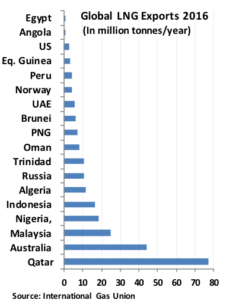
Europe is willing to diversify its suppliers to get rid of the siege of Russian gas. Until recently, Qatar was the only alternative for Europe (as we have previously noted, the Algerian gas was already the Russian gas as Gazprom owns half of Sonatrach). Now the US Shale Gas has become the main alternative to Russia. The following map shows European ports with LNG storage and conversion facilities, that are, available to US Shale Gas export:
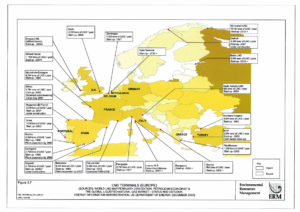
In the chart below we see the EU countries’ dependency on Russian gas. The only source to complement the gray bars to 100% is Qatar (Algerian gas is also present, but we have already told you about the fact that Russian Gazprom is a partner for it):
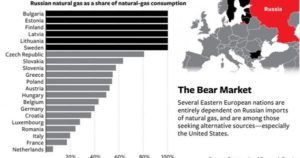
The chart below shows the North American (US and Canadian) total energy exports and export expectations for the future. While the North America was not present in export composition until recently, anticipations for the coming years predict that their gas exports will explode – so their export expectation almost entirely depends on LNG exports through tanker ships:

Deducing from these data, it is clear that the US and Qatar are facing one against the other in the world LNG market. While Turkey profits the lion’s share from the Qatari’s LNG exports to China and to the Mediterranean Europe thanks to Tayyip’s special relations with Qatar, this chalice between Qatar and Turkey is also the first obstacle in front of the US’s new global economic hegemony project.
Long Term Antagonism
Now let’s look at the long-term contradiction: the long blue (Gulf-Haifa connection) line in the first map is in conflict with the red one (Nabucco) and the long brown one (the other energy path that could be opened towards the Gulf with Tayyip-jihadists alliances). So who will supply gas to the Mediterranean Europe? Tayyip or Netanyahu?
A very recent report prepared by Tareq Baconi poops ideas about how the Eastern Mediterranean gas reserves can be operated and how the gas from these reserves can be transported to the Mediterranean countries through a submarine pipeline (Tareq Baconi, “Pipelines and Pipedreams, In the Eastern Mediterranean “, Eurpean Council on Foreign Relations, 21st April, 2017). That long article lists a bunch of chattering from solving the Cyprus “problem” till fixing the Turkish-Greek relations, to make this pipeline project feasible. But the writer himself misses to express the real obstacle: the sum of all these scattered reserves in Eastern Mediterranean is about 70 trillion cubic feet … which is a reserve that would take place hardly in the last row in the chart scaling the gas reserves above. So, based just on the Eastern Mediterranean reserves, no such a submarine pipeline can be installed towards the northern Mediterranean countries. So, the main target of this project – that, Tariq Baconi, knowingly or unknowingly missing – is eventually to connect this pipeline to Qatar. The Qatar appetite of Saudi Arabia and its other Sunni Gulf collaborators and Israel can only be understood from this point of view. So the long-term pipeline contradiction targeting to feed the European market is popping out as “Qatari + Tayyip + Iranian” conflicting to other “Sunni fiefdoms + Netanyahu” alliances.
So the long-term contradiction we described above is also overlapping on the US-Qatar LNG clash that is present in the short run agenda. What are the possible scenarios in this case?
US-Russian Alliance, in Qatar crisis too!
In the context of the pipelines, that is – as the pipeline takes time to install it – concerning the long-term antagonism, we have already described the logic of the US-Russian alliance in Middle East politics. To summarize:
1) Arctic gases that are present in Russian exclusive economic zone shall be operated and exported to the world market by the Russian-US partnership.
2) The Arctic Sea will become a new global trade route with the US-Russian alliance. This route shortens the distance between the major economies (US, EU, China) by 25% compared to traditional hot sea routes. Moreover this 25% difference applies as long as the Suez Canal remains active. If Egypt runs into chaos or if some groups from Yemen or Somalia harass the ships passing through the Red Sea, this difference will become much bigger.
3) China is trying to develop its own Shale Gas technology with urgency and for dear life. However – even if the growth rate of the Chinese economy is not considered – it is still 5 years away from reaching out to its self-sufficiency.
4) The construction of the Russian-Chinese pipeline is underway and will be ready to function within two years. China’s gas suppliers other than Russia are Qatar and Australia. So, in addition to the above reasons, the US’s blow to Qatar LNG export will further subject the China’s dependency to Russia.
Possible Scenarios
BAE has shut down its ports to Qatar’s LNG vessels for their refueling diesel. This has already hampered Qatar’s LNG exports. However the Egyptian authorities stated that they would not close the Suez Canal to Qatar ships, against the request of the Arab coalition trying to expand the port ban, argueing that everyone except the states where Egypt was at war had the right of free passage. Sitting on Suez requires Egypt to remain distant from the Saudi block.
In the early days of the crisis, there appeared articles supporting the PKK in the Saudi press. As we have mentioned above, the necessary sociological material to manipulate the emotionality of masses to fabricate either the hostility or the fraternity is always ready at the hands of the rulers. If the tension continues, in the coming days we may observe that the Sunni brotherhood will be forgotten in Turkey and that an Arab hostility will be pumped in Media by addressing to Yemeni dramatizations of the Ottoman Empire.
The Sunni-Netanyahu block expects to profit from the short-term US-Qatar conflict, for its long-term (Eastern Mediterranean pipeline) targets. However, this Sunni-Netanyahu goal also contradicts the long-term permanent US-Russian alliance. In this case, this local alliance, which expects to profit out of the US-Qatar short-term contradiction, could fail to re-arrange the region and become a vanishing mediator leading to a deeper chaos eventually serving the US-Russian alliance interests. Persistent chaos and violence in the Middle East fits to the interests of the US-Russian alliance.
Qatar may change its side, getting farther from Tayyip and Iran to submit annexing to the Sunni-Netanyahu alliance, that is, getting included into the long blue line in our map. For now, this option seems to be the only way to save its governance.
Turkish soldiers who are sent to Qatar can “protect” the palace and the family. They may escape to Turkey by taking the treasure (or part of the treasure) with bargain as against leaving the country without fight. The money coming from Qatar by this way, will make the Turkish economy to float for a while. Qatar’s dynasty also own a priceless jewels collection of the Indian Rajs, known as the “Al-Thani Collection”. The treasures of Rajs will thus come to Turkey:
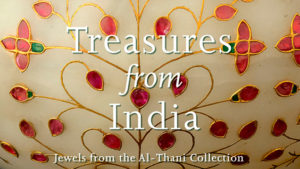
Then the Saudi army annexes Qatar. Or it can not, because it confronts Iran, and so on…
Engin Kurtay
Originally Published in Sendika.Org – June 15, 2017